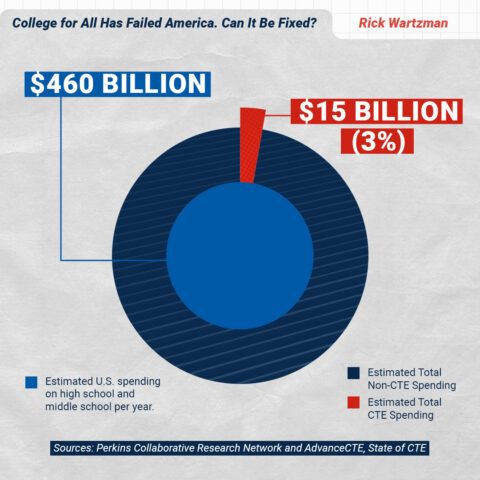
On Dec 14, 2023, Fortune and Capital & Main each posted a piece written by Rick Wartzman, our longtime partner with the Harbor Freight Leadership Lab® and the co-president of Bendable Labs. The story, titled “College for All Had Failed American. Can It be Fixed?” is a comprehensive review of the forces that pushed the U.S. education system into a “college for all” mentality, and what has been gained and lost because of that focus for young people and for our country.
Decades into the College for All effort, six in 10 American adults still don’t have a college degree. At the same time spending on Career and Technical Education makes up just three percent of the estimated overall funding for high school and middle school education in the United States.
Highlights from the story.
Decades into the College for All Effort, Rick Wartzman writes that:
Six out of 10 American adults don’t have a four-year college degree, and the majority of high school graduates today still don’t enroll right away at four-year institutions. More than a third of those who do begin a bachelor’s program don’t finish.
 Video Interview 1: Six in Ten Americans Don’t Have a College Degree
Video Interview 1: Six in Ten Americans Don’t Have a College Degree
While there appears to be renewed interest in Career and Technical Education the past few years, Rick’s story calls attention to one glaring data point that shows CTE is not being taken seriously by the K-12 education establishment:
Only three percent of U.S. public education for high school and middle school funding is spent on CTE.
Rick writes:
The numbers are stark. The United States spends an estimated $460 billion a year on education for students in high school and middle school, when it makes sense for career programming to begin. No more than $15 billion of that — about 3% — is dedicated to CTE, a review of federal and state expenditures shows.

Video Interview 2: Only Three Percent
The immensity of the CTE funding gap is indicative of the magnitude of the challenge ahead: America’s college-for-all fixation can’t be stopped by fiddling with the current system. Instead, “we need a whole new system,’’ says John White, Louisiana State Superintendent of Education from 2012 to 2020.
To get there, the dollars being invested in career education and training must skyrocket — and not by two or three times, but more like 10 or 15 times.

